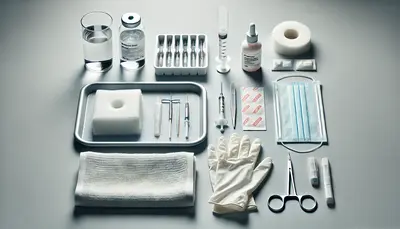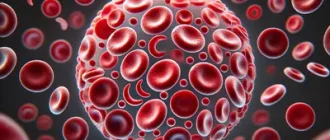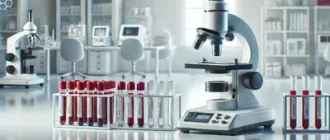Aplastic anemia, a rare but serious condition, occurs when your bone marrow fails to produce enough blood cells. This can lead to symptoms that range from mild to severe and may significantly impact daily life. Early detection is crucial for effective treatment. So, how can you identify if you have aplastic anemia?
Symptoms Progression by Severity
| Symptom | Mild (%) | Moderate (%) | Severe (%) |
|---|---|---|---|
| Fatigue | 40% | 60% | 80% |
| Infections | 30% | 50% | 70% |
| Bruising | 20% | 40% | 60% |
What is Aplastic Anemia?
Aplastic anemia is a condition where the bone marrow – the soft, spongy tissue inside your bones responsible for producing blood cells – doesn’t make enough red blood cells, white blood cells, and platelets. These deficiencies can cause anemia, increase the risk of infections, and lead to bleeding issues.
Key Statistics
- Aplastic anemia affects approximately 2 to 6 people per million annually worldwide.
- It’s more common in children and young adults, but it can occur at any age.
What are the Symptoms?
Symptoms of aplastic anemia can vary depending on the severity of the condition and which type of blood cell is most affected. Common signs include:
General Symptoms
- Fatigue and persistent weakness that may worsen over time
- Shortness of breath, even with minimal exertion or when resting
- Pale or yellowish skin, sometimes accompanied by cold extremities
Specific Symptoms by Blood Cell Type
- Low red blood cells (anemia): Rapid heartbeat, especially after mild activities, dizziness, headaches, or difficulty concentrating
- Low white blood cells: Frequent infections that linger longer than usual, slow recovery from minor illnesses, or recurrent fevers without clear causes
- Low platelets: Easy bruising from minor bumps, prolonged bleeding after small cuts, small red dots on the skin (petechiae), or frequent nosebleeds
Did you know?
Patients with aplastic anemia often mistake their symptoms for other conditions like chronic fatigue syndrome or iron deficiency anemia, delaying diagnosis. (Source: Mayo Clinic)
What Causes Aplastic Anemia?
The condition can be triggered by:
- Autoimmune disorders: The immune system attacks bone marrow, disrupting its ability to produce blood cells. This can lead to a cascade of symptoms, including fatigue and increased vulnerability to infections.
- Toxins: Prolonged exposure to certain chemicals, such as benzene, pesticides, or heavy metals, can severely damage bone marrow and hinder its cell production. Workplace safety standards are crucial to minimizing these risks.
- Medications: Certain drugs, including chemotherapy agents and some antibiotics like chloramphenicol, have been linked to bone marrow suppression. Always discuss potential side effects with your doctor.
- Infections: Viral infections, particularly Epstein-Barr virus, hepatitis, or parvovirus B19, can impair bone marrow function temporarily or permanently in some cases.
- Genetic disorders: Conditions such as Fanconi anemia or dyskeratosis congenita are inherited disorders that compromise bone marrow health, often detected in childhood but sometimes later in life.
However, in many cases, the cause remains unknown (idiopathic aplastic anemia).
How is Aplastic Anemia Diagnosed?
If you suspect aplastic anemia, consult a doctor immediately. Diagnosis involves multiple tests to confirm the condition and rule out other illnesses.
Common Diagnostic Tests
- Complete Blood Count (CBC): This fundamental test measures the levels of red blood cells, white blood cells, and platelets in your blood. It provides an overview of your bone marrow’s output and helps detect abnormalities in early stages.
- Bone Marrow Biopsy: This definitive diagnostic test involves extracting a small sample of bone marrow, usually from the hip bone, to closely examine cell production and identify specific abnormalities or marrow deficiencies.
- Reticulocyte Count: This test evaluates the number of young red blood cells in your bloodstream, offering insights into how actively your bone marrow is producing new cells. It’s especially useful for understanding anemia severity.
- Flow Cytometry: A highly specialized test, flow cytometry analyzes cells in your blood and bone marrow to pinpoint autoimmune disorders or other immune-related issues contributing to aplastic anemia.
- Genetic Testing: Screening for inherited conditions linked to aplastic anemia, such as Fanconi anemia or other genetic disorders, is crucial. It can also aid in identifying familial risks and guide treatment strategies.
Diagnostic Tests Popularity
Pro Tip: If your symptoms persist despite normal blood test results, request a bone marrow biopsy for a more accurate diagnosis.
What Are the Risk Factors?
While anyone can develop aplastic anemia, certain factors increase your risk:
- Exposure to toxic chemicals
- Previous chemotherapy or radiation therapy
- Chronic viral infections
- A family history of bone marrow disorders
Treatment Options
Once diagnosed, treatment depends on the severity of the condition and the patient’s overall health. Common treatments include:
1. Blood Transfusions
Blood transfusions are often the first line of treatment, helping to temporarily relieve symptoms by increasing red blood cell and platelet counts. While transfusions provide immediate relief from fatigue, anemia, and bleeding issues, they are not a permanent solution. Repeated transfusions can lead to complications such as iron overload, requiring additional management strategies like iron chelation therapy.
2. Immunosuppressive Therapy
Drugs like cyclosporine and antithymocyte globulin (ATG) suppress the immune system to allow bone marrow recovery. This approach is particularly effective for patients without a compatible bone marrow donor. The therapy often involves a combination of medications and close monitoring for side effects, such as an increased risk of infections. For many patients, immunosuppressive therapy can lead to partial or complete remission, allowing them to regain a better quality of life.
3. Bone Marrow Transplant
A bone marrow transplant is a potentially curative option for younger patients with severe aplastic anemia and a compatible donor. The procedure involves replacing the damaged bone marrow with healthy stem cells from a donor, usually a sibling. Although it offers high success rates, particularly in younger patients, it carries risks such as graft-versus-host disease (GVHD) and requires significant recovery time. Advances in transplantation techniques have made this option more accessible and safer over the years.
4. Growth Factors
Medications like filgrastim, also known as granulocyte colony-stimulating factor (G-CSF), stimulate the production of white blood cells, reducing the risk of infections. These growth factors are often used in combination with other therapies, helping to stabilize patients and improve their overall prognosis. Regular administration of these agents can be a game-changer for patients with severely low white blood cell counts.
5. Infection Management
Given the increased susceptibility to infections, prophylactic antibiotics or antifungal medications may be prescribed to reduce infection risks. Infections are a leading complication in aplastic anemia, making prevention and early treatment critical. Patients are often advised to maintain rigorous hygiene practices, avoid exposure to sick individuals, and seek immediate medical attention at the first sign of illness. Advanced infection management protocols have significantly improved survival rates and reduced hospital stays for patients with compromised immune systems.
Treatment Success Rates
Note: Early diagnosis and tailored treatment significantly improve survival rates. According to the American Society of Hematology, bone marrow transplants have a success rate of 80% in patients under 20 years old.
When to See a Doctor
Seek medical attention if you experience:
- Unexplained fatigue or weakness
- Frequent infections
- Excessive bleeding or bruising
Tracking Your Symptoms
Keep a symptom diary and note patterns such as worsening fatigue, prolonged infections, or increased bruising. Sharing detailed information with your doctor can aid in faster diagnosis.
Lifestyle Adjustments for Management
While medical treatment is essential, lifestyle changes can complement therapy:
- Avoid exposure to toxic chemicals and secondhand smoke, as these can worsen symptoms and hinder recovery. Consider creating a safer living environment by minimizing contact with harmful substances and using protective gear if exposure is unavoidable.
- Eat a balanced diet rich in iron, vitamin B12, and folate to support blood cell production and overall health. Including foods like leafy greens, lean meats, and fortified cereals can make a significant difference in nutrient intake.
- Practice good hygiene, such as frequent handwashing and sanitizing high-touch surfaces, to reduce infection risks. Simple steps like wearing a mask in crowded places can further safeguard your immune system.
- Regularly follow up with your hematologist to monitor blood levels and adjust treatments as necessary. Consistent communication with your healthcare provider ensures timely interventions and optimal care.
Did you know?
Patients with aplastic anemia are often advised to avoid crowded places and sick individuals due to their weakened immune systems. (Source: CDC)
Editorial Advice
If you suspect aplastic anemia, don’t wait. Consult a healthcare provider and insist on comprehensive testing. Remember, early intervention can save lives. Partner with your doctor to explore all available treatment options, and make the necessary lifestyle changes to support your health.
Survival Rates by Age Group
| Age Group | Survival Rate (%) |
|---|---|
| 0-20 years | 90% |
| 21-40 years | 75% |
| 41-60 years | 60% |
| 61+ years | 40% |







